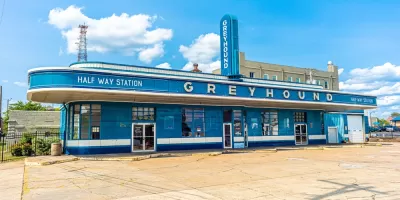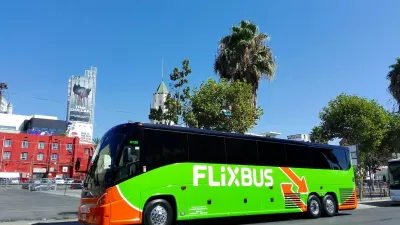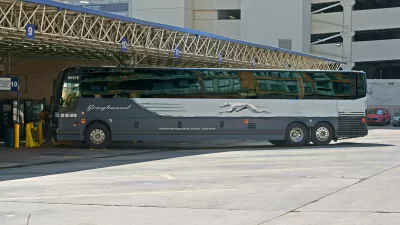The closure of many former Greyhound bus terminals is making intercity bus travel more inconvenient for the riders who depend on it.

Intercity bus riders are seeing a loss of dedicated bus stations and amenities. As Dan Zukowski explains in Smart Cities Dive, “After FlixMobility acquired Greyhound in October 2021, Greyhound’s former owner, FirstGroup, began selling the bus company’s real estate holdings, including its privately owned bus stations.”
Now, with many former Greyhound stations closing, bus passengers often have to wait on public sidewalks without amenities like public restrooms or air-conditioned waiting rooms. According to Joe Schwieterman, director of the Chaddick Institute for Metropolitan Development at DePaul University, “You have lots of disadvantaged populations that really suffer when indoor waiting rooms are lost, or you end up [with stops] at convenience stores and hours are limited.”
Some cities provide access to existing facilities, such as Union Station in downtown Los Angeles, but, according to an annual report on the intercity bus industry from the Chaddick Institute, “The problems this creates have yet to attract much attention from local policymakers, some of whom have done little to help travelers on intercity buses in the past.”
The report warns that the closures, along with an ongoing operator shortage, will prevent bus companies from improving services and bringing ridership back up to pre-pandemic levels. It also predicts a rise in premium services such as onboard meals and lie-flat beds to attract a wider variety of passengers.
FULL STORY: Intercity bus station closures create problems for riders

Alabama: Trump Terminates Settlements for Black Communities Harmed By Raw Sewage
Trump deemed the landmark civil rights agreement “illegal DEI and environmental justice policy.”

Study: Maui’s Plan to Convert Vacation Rentals to Long-Term Housing Could Cause Nearly $1 Billion Economic Loss
The plan would reduce visitor accommodation by 25% resulting in 1,900 jobs lost.

Why Should We Subsidize Public Transportation?
Many public transit agencies face financial stress due to rising costs, declining fare revenue, and declining subsidies. Transit advocates must provide a strong business case for increasing public transit funding.

Paris Bike Boom Leads to Steep Drop in Air Pollution
The French city’s air quality has improved dramatically in the past 20 years, coinciding with a growth in cycling.

Why Housing Costs More to Build in California Than in Texas
Hard costs like labor and materials combined with ‘soft’ costs such as permitting make building in the San Francisco Bay Area almost three times as costly as in Texas cities.

San Diego County Sees a Rise in Urban Coyotes
San Diego County experiences a rise in urban coyotes, as sightings become prevalent throughout its urban neighbourhoods and surrounding areas.
Urban Design for Planners 1: Software Tools
This six-course series explores essential urban design concepts using open source software and equips planners with the tools they need to participate fully in the urban design process.
Planning for Universal Design
Learn the tools for implementing Universal Design in planning regulations.
Smith Gee Studio
Alamo Area Metropolitan Planning Organization
City of Santa Clarita
Institute for Housing and Urban Development Studies (IHS)
City of Grandview
Harvard GSD Executive Education
Toledo-Lucas County Plan Commissions
Salt Lake City
NYU Wagner Graduate School of Public Service





























